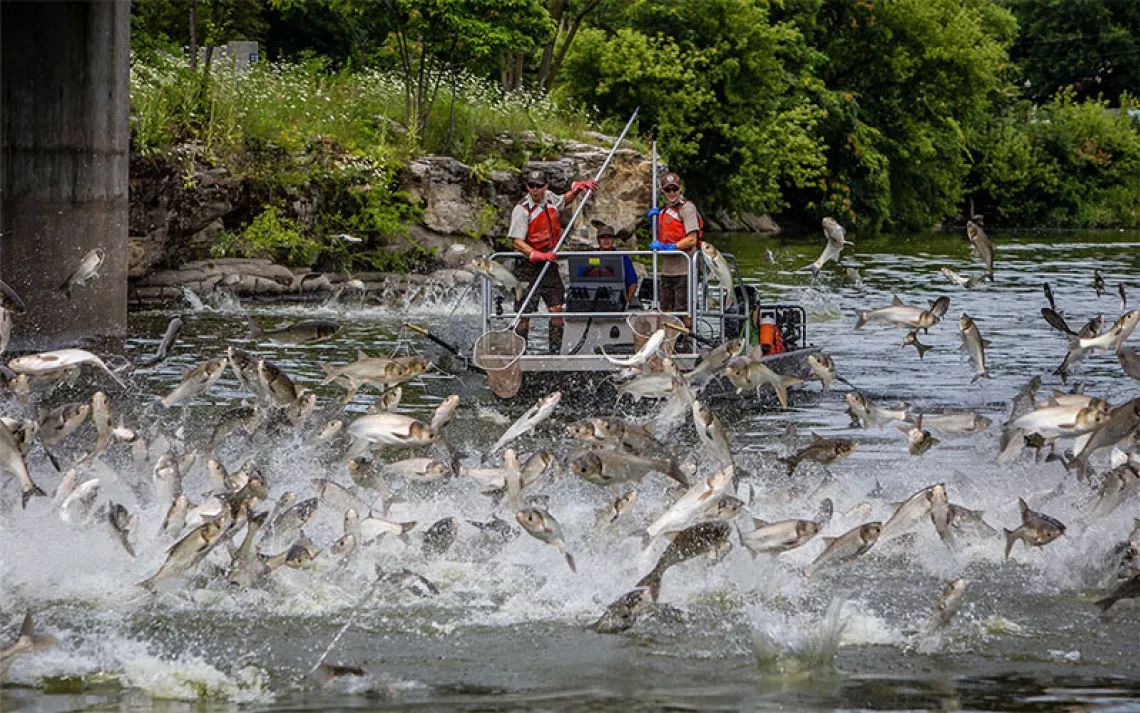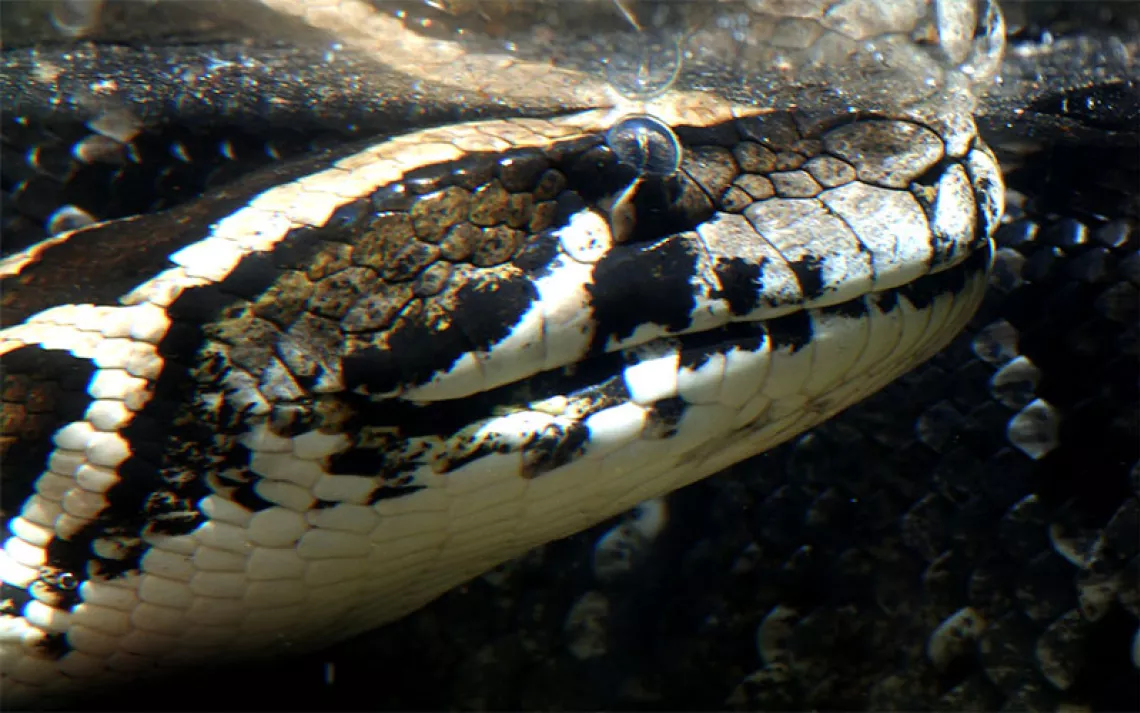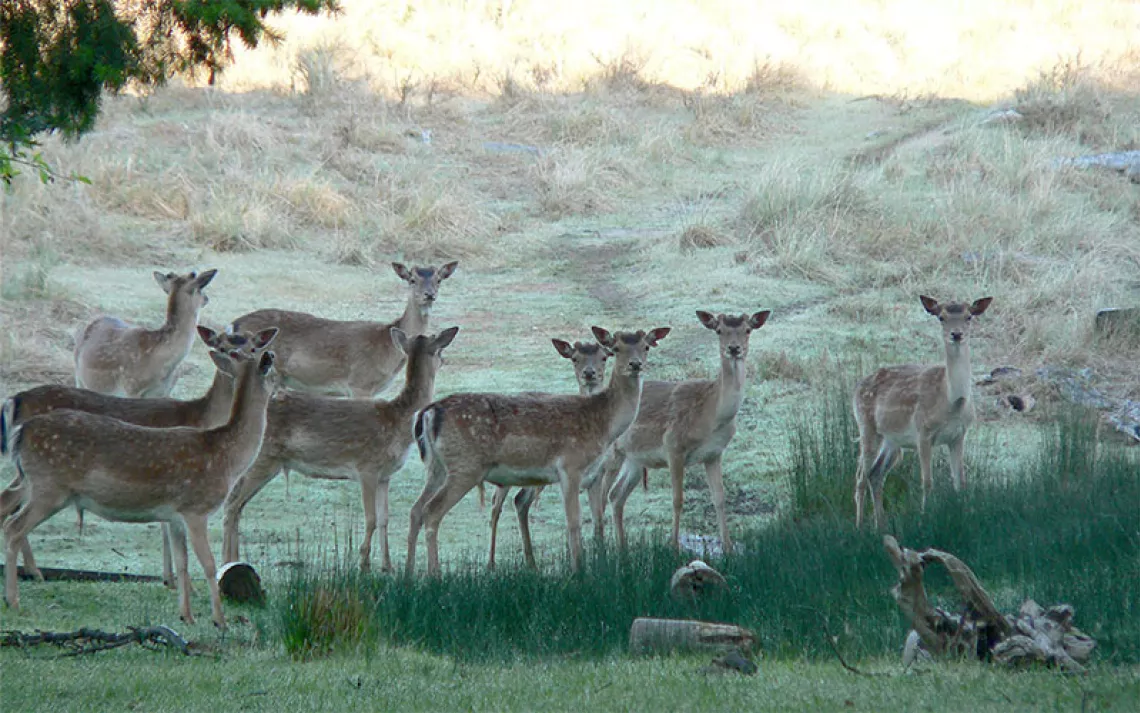Good Dogs Against Invasive Species
Is man’s best friend also nature’s best protector?

Photos courtesy of Working Dogs for Conservation
In summer 2019, visitors to Oklahoma’s Chickasaw National Recreation Area’s Lake of the Arbuckles met a new line of defense in the fight against aquatic invasive species: a nose (actually, three) for detecting them.
The dogs and their handlers waited eagerly as visitors lined up their boats to enter the Lake of the Arbuckles. Raine, a golden retriever, and border collies Wisp and Darby had a job to do. They circled each boat and sniffed for zebra mussels and quagga mussels—sinister little hitchhikers that attach themselves to boats only to spread like a plague through freshwater lakes.
“Invasive mussels can kill a lake,” Dan Winings, biological resource tech for the Chickasaw National Recreation Area, told Sierra. “They are masters at filtering water. On the surface, that looks OK because they can make a lake really clear. But they eat all the algae that little fish eat, and the little fish feed the bigger fish. Invasive mussels can absolutely kill a lake.”
In June, the three dogs were on the hunt for signs of the mussels, and they were working quickly. Their sensitive noses can inspect an average-size bass boat in under a minute, far faster than any person can. Plus, they can detect invasive species in hard-to-see parts of the boats.
Being cute doesn’t hurt either; having friendly dogs on hand gives the National Park Service another way to educate the public about how to stop the spread of zebra and quagga mussels. (People are more open to inspections when the inspector is wagging its tail.)
The dogs were in Oklahoma for three weeks this summer, checking boats at the park boat launches before working at five other parks, as part of a summer-long collaboration between the National Park Service, detection-dog program Working Dogs 4 Conservation, and SP8 Ecological Services to help share the message about how to prevent the spread of aquatic invasive species.

SNIFFING OUT THE ENEMY
Invasive species cost the US economy over $120 billion per year. Zebra and quagga mussels, in particular, are of grave concern—46 of America’s 50 states have an infestation.
According to the Bureau of Reclamation, these mussels breed at lightning speed and can choke up water facility infrastructure: water intakes, gates, diversion screens, hydropower equipment, pumps, pipelines, and boats. Mussels frequently infest and cripple water and hydropower dams, and they’re lethal to areas’ natural ecology.
More than 20 years ago, Working Dogs 4 Conservation founders Megan Parker, Deborah Woollett, Aimee Hurt, and Alice Whitelaw figured that because dogs were skilled in narcotics and cadaver detection and search and rescue, they could be used in wildlife conservation as well.
“In the 1990s, it became possible to get DNA from scat,” explains Hurt. “This led to the realization that we needed a better way to systematically find animal scat, as a means to then be able to noninvasively monitor wildlife populations.”
The four founders of WD4C, with their biology and dog backgrounds, researched training resources and adapted the methods of other detection disciplines—like search and rescue and narcotics—to start to build the foundation of the field that has become known as conservation detection.
Today, Working Dogs 4 Conservation dogs are used for preventing wildlife trafficking, ecological monitoring, invasive species detection, and wildlife monitoring. They have traveled to five different continents—helping to catch poachers in Africa and find big cat scat in Central America. Stateside, they’ve detected emerald ash borer eggs, larvae, and human adults. Using the dogs’ sense of smell to protect wildlife and wild places, WD4C trained the animals to find some of the hardest-to-detect species, including microscopic larvae from zebra mussels, weeds before they break the surface, and animals that live below ground.
So where does one find this talent? Most often, from shelters.
IT TAKES A SPECIAL KIND OF DOG
Of the 35 dogs that work at WD4C, many come from pet shelters. All 35 have one thing in common: They are “ball crazy.”
“Most of them come from shelters and rescues because these dogs are really hyper,” says Fratt. “Someone gets this adorable puppy and they're like, ‘Oh boy, Labs are great family dogs.’ And then this dog grows up to be a ball fiend who's shredding your cabinets.”
The organization maintains a network of people who watch shelters for good candidates—typically Labs, border collies, German shepherds, or Belgian Malinois breeds. “We're not picky about breed per se, but there are certain breeds where it's much more likely to see the behavioral characteristics we're looking for,” says Fratt. “You don't see a lot of breeds that are really interested in hiking for eight hours a day.”
The trainers use balls and toys as treats. To train a dog to detect bear scat, they’ll give him a toy once he finds it. The rigor ramps up as trainers hide scat in various locations, or with other scat. Every time the dog is successful, he gets to play with its toy.
This technique works for anything WD4C wants the dogs to detect. In fact, many of the canines have a variety of specialties. “We'll do 10 days of looking for bear scat over the summer," Fratt says, "and then we'll do two weeks of zebra muscle work and then we'll do two weeks of looking for this rare species of lizard, and then two weeks of this invasive species of plant out in Iowa.”
Some dogs get passed around through various projects quite a bit. “We also have just over 20 dogs that are scattered across the globe but that are more permanently stationed with an organization and helping on a daily level.”
Tigre was bred and raised to be a service dog but flunked out of the program. “He tried to steal tennis balls off of people's walkers, which is not helpful if you're an elderly person with a recovering broken hip,” says Fratt. “So he was not destined to be a service dog. Tigre now lives in Costa Rica, and he and his partner partnered with an organization down there called Panthera, which studies native big cats.”
WD4C also has about a dozen dogs stationed in Africa, primarily doing antipoaching work—they sniff out guns and ammo, skins, bushmeat, pangolin scales, ivory, rhino horn.
The organization is always on the lookout for shelter dogs that fit the bill and who want the ball.
“It's always really helpful for us if people can keep an eye out for these really crazy dogs,” says Fratt. “If you work or volunteer in or near a shelter or if you're on Craigslist and you see someone who's like, ‘I'm getting rid of this dog; he’s torn through four cabinets trying to get his tennis ball’—like, good God, we want that dog.”
But the dogs aren’t just hired noses—they’re family too.
“WD4C dogs remain a part of our pack for life, and if they are ever hurt or are ready to retire, we have a soft couch waiting for them,” Fratt reports.

A SUMMER PARTNERSHIP
Preventing the spread of invasive species is a $5 billion cure—that’s the annual cost of mitigating invasive mollusks. WD4C had been in talks with Glacier National Park for some time, and this year, the NPS finally put out a competitive bid to do the inspections. WD4C won. While zebra and quagga mussels are rampant throughout America, they haven’t yet clogged up the most popular parks in the northern US, like Yellowstone, Glacier, and Grand Teton, and they aren’t found at all in Montana and Alberta. WD4C is helping to keep it that way.
While zebra and quagga mussels have not been detected at Oklahoma’s Lake of the Arbuckles, many other lakes in the area are infested. “Most of our boaters are local,” says Winings. “Many of their boats have been in the lakes that do have the mussels. The dogs inspected about 325 to 350 boats, and not a single zebra mussel was found.”
The program this summer with WD4C was part prevention inspection and part public relations, to make sure the lake stays free of infestation. And the dogs were a welcome addition to the parks inspected.
Hurt reports that, in addition to the NPS contract, WD4C started a neighboring program, the Alberta Environment and Parks Conservation K9 Program, through which three dog-handler teams conduct inspections and outreach for invasive mussels on watercraft.
“We also have used dogs to detect mink and otter scat—top-level predators of river systems, thus bio-accumulators—as a vehicle to analyze for heavy metal, flame retardant, and pharmaceutical contamination in Montana waterways,” she says. “Also, we have performed proof-of-concept on detecting invasive fish like brook trout in flowing water.”
Dogs may be man’s best friend, and with the right training, they can also be nature’s best protector. With that in mind, WD4C started a program in 2015 called Rescues 2 the Rescue, designed to help pet shelters around the world identify dogs that could be used for detection.
“We're looking for a very specific type of dog. We're very, very picky, which is why it's so helpful for us to have a lot of people keeping their eyes open,” says Fratt. “We will say no to most dogs, but if enough people are helping us look, we will find the right ones eventually. And they are usually the dogs no one else wants.”
 The Magazine of The Sierra Club
The Magazine of The Sierra Club



